
Constellations have fascinated humans for centuries, guiding sailors, inspiring myths, and helping us understand the cosmos. But what exactly are these star patterns? Constellations are groups of stars forming recognizable shapes, often named after mythological figures, animals, or objects. There are 88 officially recognized constellations by the International Astronomical Union. Each one has its own unique story and significance. From the famous Orion to the lesser-known Phoenix, these stellar formations have more to them than meets the eye. Ready to learn some cool facts about constellations? Let's dive into the starry night and uncover 28 intriguing tidbits that will make you look at the night sky differently!
Key Takeaways:
- Constellations are star patterns named by ancient cultures. They helped with navigation, agriculture, and timekeeping. Today, they're used in astronomy, education, and even space missions!
- Some famous constellations include Orion, Ursa Major, and Cassiopeia. They have unique shapes and myths. Constellations continue to inspire art, literature, and technology in modern culture.
What Are Constellations?
Constellations are patterns of stars visible in the night sky. These star groupings have been recognized and named by various cultures throughout history. Let's dive into some fascinating facts about these celestial formations.
-
Ancient Origins: Many constellations have origins dating back to ancient civilizations like the Greeks, Egyptians, and Babylonians.
-
88 Official Constellations: The International Astronomical Union (IAU) officially recognizes 88 constellations.
-
Zodiac Constellations: Twelve of these constellations form the zodiac, which is used in astrology.
-
Named After Mythology: Many constellations are named after mythological figures, animals, or objects.
-
Different Cultures, Different Constellations: Various cultures have their own unique constellations and star stories.
How Constellations Helped Ancient People
Constellations were not just for storytelling. They played a crucial role in navigation, agriculture, and timekeeping.
-
Navigational Aids: Sailors used constellations to navigate the seas before modern instruments.
-
Agricultural Calendars: Farmers relied on constellations to determine planting and harvesting times.
-
Timekeeping: Ancient civilizations used the movement of constellations to track time and seasons.
-
Cultural Significance: Constellations often held religious or cultural significance, guiding rituals and festivals.
-
Star Maps: Early astronomers created star maps based on constellations to study the night sky.
Modern Uses of Constellations
Even today, constellations serve various purposes beyond their historical uses.
-
Astronomical Research: Scientists use constellations to locate and study celestial objects.
-
Amateur Astronomy: Stargazers and amateur astronomers use constellations to find stars and planets.
-
Educational Tools: Constellations are used in education to teach about the night sky and astronomy.
-
Space Missions: Space agencies use constellations for navigation and orientation in space.
-
Cultural Heritage: Constellations continue to be a part of cultural heritage and storytelling.
Interesting Facts About Specific Constellations
Some constellations have unique and intriguing characteristics that set them apart.
-
Orion: One of the most recognizable constellations, Orion is named after a hunter in Greek mythology.
-
Ursa Major: Known as the Great Bear, Ursa Major contains the Big Dipper, a famous asterism.
-
Cassiopeia: This constellation is easily identified by its distinctive "W" shape.
-
Scorpius: Representing a scorpion, Scorpius is one of the brightest constellations in the sky.
-
Crux: Also known as the Southern Cross, Crux is a key navigation aid in the Southern Hemisphere.
Fun Facts About Constellations
Here are some fun and lesser-known facts about constellations that might surprise you.
-
Constellation Names: Some constellations have names that are over 2,000 years old.
-
Star Brightness: The brightness of stars in a constellation can vary greatly, with some being much closer to Earth than others.
-
Seasonal Visibility: Not all constellations are visible year-round; some can only be seen during certain seasons.
-
Constellation Shapes: The shapes of constellations can appear different depending on your location on Earth.
-
Constellation Myths: Many constellations have fascinating myths and legends associated with them.
Constellations in Modern Culture
Constellations continue to inspire and appear in various aspects of modern culture.
The Stars Above
Constellations have fascinated humans for centuries. From guiding sailors across oceans to inspiring countless myths, these star patterns hold a special place in our history. Each constellation tells a story, whether it’s Orion the Hunter or the mystical Pegasus. They’ve helped us navigate, mark seasons, and even sparked our imagination.
Understanding constellations isn’t just about looking up at the night sky. It’s about connecting with our past and appreciating the vast universe we’re part of. Next time you gaze at the stars, remember the tales they tell and the science behind them. Whether you’re an astronomy buff or just curious, there’s always something new to learn about these celestial wonders.
So, keep looking up. The night sky is full of mysteries waiting to be explored. The stars above are more than just lights; they’re a link to our shared human experience.
Frequently Asked Questions
Was this page helpful?
Our commitment to delivering trustworthy and engaging content is at the heart of what we do. Each fact on our site is contributed by real users like you, bringing a wealth of diverse insights and information. To ensure the highest standards of accuracy and reliability, our dedicated editors meticulously review each submission. This process guarantees that the facts we share are not only fascinating but also credible. Trust in our commitment to quality and authenticity as you explore and learn with us.
